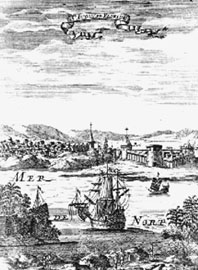

 | Page 503 |  |
eighteenth-century Spanish frontier forts, including San Luis (Boyd, Smith, and Griffin 1951), Fort Pupo (Goggin 1951), and at San Marcos de Apalache on the Gulf coast (Smith 1956:76–77). The site of Santa Rosa Pensacola, Florida (1720–1752) was also located and studied during this period (Smith 1965).

Drawing of St. Augustine, Florida
(Ann Ronon Picture Library)
Spanish forts and town sites were also among the first subjects of historical archaeology in the Caribbean. One of the first restoration-oriented Spanish colonial archaeological projects in the region was carried out in Puerto Rico by historian Adolfo de Hostos at the site of Caparra. The remains of the monumental stone structure and its associated artifacts were thought to be remnants of Ponce de Leon’s palace, in which he lived as the first governor of Puerto Rico (Pantel et al. 1988). Thirty years later another large-scale excavation in San Juan was carried out at the fortress of El Morro by Smith, also in support of renovation and restoration (Smith 1962; Manucy and Torres Reyes 1973).
Excavations were conducted by C.S. Cotter, a plantation agent and avocational archaeologist in Jamaica, at the site of Sevilla Nueva in 1937– 38 (Cotter 1948; Goodwin 1946, 11). The site is exceptional for the architecture and ornate masonry work uncovered there, which manifests some of the earliest known American-European artistic syncretism (Cotter 1948). Investigations were continued by Cotter under the auspices of the Institute of Jamaica in 1953 (Cotter 1970; Woodward 1988), and a major program of excavation was carried out at the Sevilla Nueva between 1982 and 1990 by Spanish archaeologist Lorenzo Lopez y Sebastián.
Archaeological investigations (1515–1545) at the Spanish settlement of Nueva Cádiz, Venezuela, began in the late 1940s with the work of Alfredo Boulton and José M. Cruxent (Cruxent and Rouse 1958, 58–60), with excavations continuing sporadically into the 1960s (Willis 1976). Nueva Cádiz was established to take advantage of the rich pearl beds located in 1598 near the island of Margarita, off the coast of Venezuela. It was essentially a single-resource extractive community, to which large numbers of Caribbean Indians were relocated and enslaved. The archaeological work there provided one of the first materially based descriptions of the conditions under which Caribbean Indians were enslaved and exploited, and underscored the dramatic differences in the lives of the Spaniards and Indians inhabiting the city (Cruxent and Rouse 1958; Willis 1976). The materials from Nueva Cádiz also formed an important baseline resource for understanding the first half of the sixteenth century and for Spanish colonial material remains dating.
One of the most intensive and long-lived programs of historical archaeology in Spanish town sites began in the Dominican Republic in the 1940s. Intermittent excavations continued at La Isabela through the period (Puig-Ortiz 1972), and investigation was begun at the early-sixteenth-century site of Concepción de la Vega (Palm 1952). Another building thought to be a residence of Ponce de Leon was later studied in the Higuey region of the Dominican Republic (Boyrie-Moya 1964).
Historical archaeology in the Dominican Republic became particularly active during the 1950s and 1960s, when a major program of investigation
 |  |